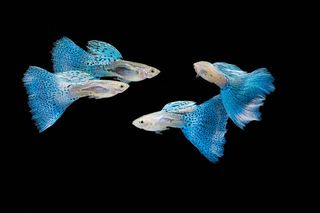Male Guppies Harass Potential Mates into 'Girl Fights'

Best girlfriends might never let a man come between them — unless they're Trinidadian guppies. Among these fish, the presence of a harassing male can disrupt female social networks, causing female-against-female aggression, new research indicates.
During mating season, male guppies either will woo females with their shiny coats or they will harass the smaller females into mating by using nipping and chasing behaviors. Earlier research found that the presence of a harassing male seemed to disrupt female social networks, though it was not known how.
"Aggression could be a good candidate for how the female's opportunities for bonding could be affected," study researcher Safi-Kristine Darden, of the University of Exeter in southwestern England, told LiveScience. "But also, just generally the amount of time they have to become familiar with each other and establish dominance hierarchies" decreases when males are nipping at females' heels.
Guppy social networks
Guppies are constantly flitting from one social group to another in the water. Though seemingly superficial, the distinct pairs that females form can improve foraging and provide protection from predators.
To see how harassment affects the female social bonds, the researchers put each of three pairs of small guppies (a random mix of females and small males) into a transparent cylinder, with all cylinders placed within a larger tank. They then introduced either a pair of female guppies or a male and a female guppy into the larger tank.
The researchers found that when paired with a male, the female that was plopped into the larger tank spent less time hanging out near each group and moved more quickly from one cylinder to the next. Also, it was the female, rather than the male, that initiated the move from one group to the next, which suggests the female was trying to escape the actions of the aggressive male.
Sign up for the Live Science daily newsletter now
Get the world’s most fascinating discoveries delivered straight to your inbox.
"When harassing males are around females, females simply have less time to spend with other females, probably because they are trying to escape from the male attention," Darden told LiveScience.
Female-on-female aggression
The researchers also tested the aggressive tendencies of the guppies in all-female or in mixed-sex groups in the presence of a harassing male. By adding a food patch to the area, the researchers watched how the female guppies competed over the food.
In mixed-sex groups, females used nips, nudges, chasing and tail beatings to take over food patches, deterring other females from coming near. "They were performing this aggression toward other large females," Darden said. "The level of aggression was much greater when they were in the presence of the males."
The researchers believe this might have been a case of misplaced aggression. The female takes out its frustration over a harassing male on other females instead — possibly because of male hormones in the water, or other chemical signals between the fish.
The study was published Oct. 4 in the journal Biology Letters
You can follow LiveScience staff writer Jennifer Welsh on Twitter @microbelover. Follow LiveScience for the latest in science news and discoveries on Twitter @livescience and on Facebook.
Jennifer Welsh is a Connecticut-based science writer and editor and a regular contributor to Live Science. She also has several years of bench work in cancer research and anti-viral drug discovery under her belt. She has previously written for Science News, VerywellHealth, The Scientist, Discover Magazine, WIRED Science, and Business Insider.
Most Popular




